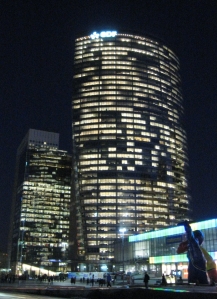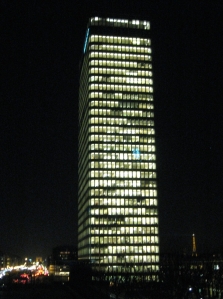If you ever find yourself speaking to an architect at a party, most likely the word transparency and the supposed need for it is going to come up over and over. This is a recent concern for the building arts. Modern architecture, traditionally, has been philosophically focused on honesty of materials, or the meaning of forms. Transparency is in a way a renunciation of architecture. Its purpose is to make the form of a building as unnoticeable as possible. Architecture just gets in the way, so making it unnoticeable is the best design choice. Nothing is the new something.
Glass-covered office buildings have been the norm for decades, mostly because corporations are not taken in by architectural fashion and just want regular, boring, functional floor space. The glass curtain wall dominates the office parks and central business districts the world over. The physics of light being what they are, for most of the business day the building offers nothing but a mirrored glass box to the world, or for worse buildings, repeating checkerboard or line patterns (Class II behavior in Stephen Wolfram's categories). The Houston-style CBDs have been described as soulless and boring, But something strange happens when the sun sets. The soulless, boring cluster of glass boxes becomes a setting worthy of postcards. A glass city at night has a completely different emotional and psychological effect on its visitors, something I've witnessed many people express, and have felt myself.
The patterns that the interior of an office building takes are controlled by its inhabitants, and, so far as the architect who designed the thing is concerned, purely random. And what happens at night to a glass tower is that the architecture of the building, the geometry controlled by the architect, blacks out and becomes indistinguishable from the background, while the lit floors are exposed for everyone to see. This nocturnal geometric transformation we can call the phenomenon of Cinderella architecture.
That a soulless glass city becomes beautiful at night cannot be accounted for only by lighting. A parking lot is lit up at night as well, and no one feels any better about it. Instead, I believe that the phenomenon of Cinderella architecture is an example of structured chaos. The office buildings, while no longer being themselves visible, create common frames within which random events are pictured. These random events can be as simple as lights being switched on or off, and can go into deeper details such as the placement of furniture. The result, seen from far away, is a geometric pattern that is overwhelming in complexity, especially when occurring in thousands of windows over dozens of buildings.
Looking for evidence of this phenomenon, I went to Paris' version of the Houston CBD, the La Défense office city in the first ring outside Paris, in the sunset hours of a working day. La Défense holds a reputation for having the most boring kind of corporate architecture, but even this small district benefits from the Cinderella effect. Here are some pictures that I hope will illustrate my point.
The regular day-time modern business district.
The same spot at night.
The lower floors of the building on the left are not occupied and the visual complexity of the building suffers from it.
This building was one of the first built on the site, and is one of the most obsolete, but it lights up as much as any other at night, if not more.
How can the most routine kind of modern corporate architecture be creating such complexity? The answer is that it is not the buildings that create the complexity, it is the people living in them, adapting their environment to suit their activities. What makes it beautiful is the common frame that this adaptation takes place in. The frame is the architecture, the complexity is the adaptations that people make with it.






Interesting observations, and in general I agree. However, I would add that another powerful part of this film is the dystopian idea that in a "dis-aggregated" world of suburban limbo, violent death is inevitable, and often emerges out of sheer boredom.